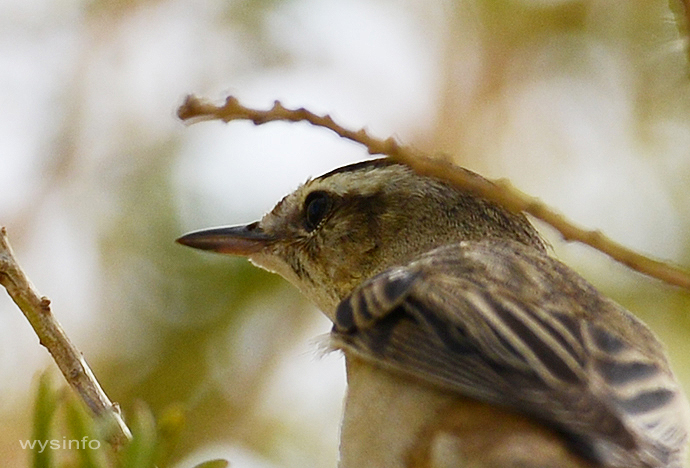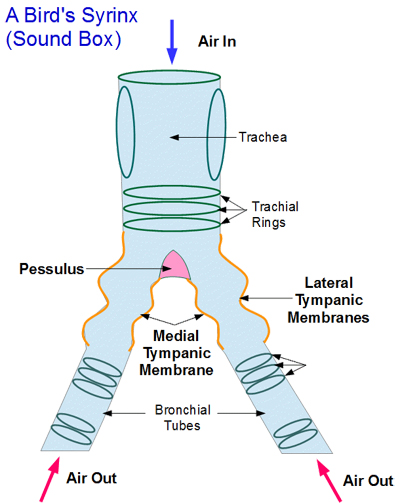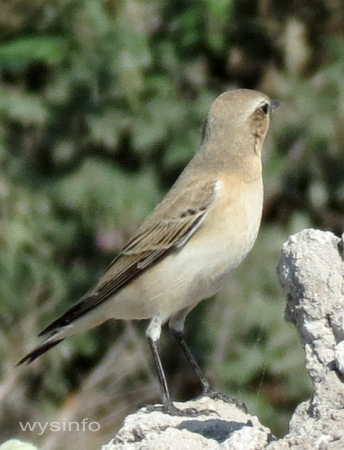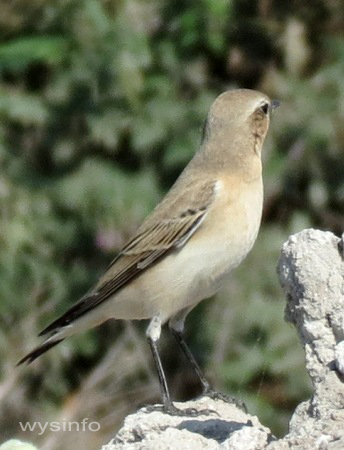Page Content
- Songbirds are a Family in the Order of Passeriformes
- Bird Calls Vs. Bird Songs
- How Birds Sing
- Vocal Development, Dialect, Copying
Songbirds are a Family in the Order of Passeriformes
While all birds communicate, only some of them are granted the quality of vocals at a level that befits, what we call, songbirds.
Songbirds are members of the Oscines of the Passeriformes order, which is divided into three suborders (Oscines, Sub Oscines and Acanthisitta).
The two main suborders – Oscines and Sub Oscines – differ in the structure of their vocal mechanisms. The third suborder – the Acanthisitta (New Zealand Wren) – is a much smaller suborder, believed to be unique to New Zealand.
Blackbird Vocals
The Oscines is the group of birds in which singing is extremely developed. While the sound of some birds in other groups is fairly pleasant, it is from the Oscines that we hear vocals which reach a high level of complexity that we recognize as truly musical.
Can you identify the bird(s) of the recording below?
Answer is at the end of this page
Bird Calls Vs. Bird Songs
Ornithologists tend to distinguish between a call and a song by the length and complexity of the vocalization.
What is a Bird Call?
A bird ‘call’ is a sound that is made by birds in order to accomplish a basic level of communication enabling the birds to survive and function as a group. For example there are calls of alarm to warn other birds of danger, or ‘pinging’ calls that let birds of the same flock keep track of each other while travelling. Interestingly, some experiments have indicated that alarm calls are recognized across different species of birds, not just by the same species as the caller.
These calls are generally considered to be innate rather than learned. Some of these calls can be very complex – but even complex calls are not considered to be songs.
Bird Call – Greenfinch (16)
What is a Bird Song?
A bird song is a well-developed vocal feature, primarily of Oscine passerines, and generally must be partly or entirely learned. Songs identify the species of the singer.
Songs of Various Birds by Wysinfo
Song is used to define a male’s territory, thus warning other males from entering the ‘declared’ protected occupied zone. It also serves as an inviting song for the female to join the potent male.
The number of different ‘songs’ that the male can perform is another factor used by the female to decide who is the lucky one to win her attention. The wider the repertoire the male has, the greater is his chance to win.

European Robin – a Song and a Call
Song – Courtesy Of: Fernand Deroussen, XC161532. Accessible at www.xeno-canto.org/161532.
Call – Courtesy Of: Marco Dragonetti, XC160887. Accessible at www.xeno-canto.org/160887.

A Sedge Warbler Song
Courtesy Of: Fernand Deroussen, XC161916. Accessible at www.xeno-canto.org/161916.
Warblers are small perching birds of the passerine suborder. Currently there are a few dozens species that are classified within this genus. They are not necessarily closely related to one another, but share some characteristics, such as being fairly small, vocal, and insectivorous.
For example – sedge warbler, reed warbler, common whitethroat (Sylvia communis) are common and widespread typical warbler.
Northern Wheatear
Scientists tend to refer to vocals with particular configuration of syllables and phrases that are repeated in a stereotyped fashion as a ‘song-type’.
While the majority of the males among all songbirds have a relatively small repertoire, there are some birds like the brown thrasher or the blackbird that stand out with numerous song types.
Blackbird singing at twilight
The evolution of song repertoires is believed to be a result of the process of sexual selection arising from the competition between males over the female.
Ornithologists claim, based on experimental evidence, that song is an important factor in coordinating the reproductive cycle between mates. Male song is known to stimulate ovarian development and laying eggs among some birds such as budgerigars. It is also believed to speed up nest-building activity, for example in female canaries.
How do Birds Sing
When a bird inhales it takes in air through its bill. The air goes down through the bird’s throat into its trachea, the windpipe. The windpipe splits into what is called the bronchial tubes to carry the air into each of the bird’s lungs. Air is then processed in the lungs and exhaled back along the same path. As in humans, this route serves for another function, that is, the generation of sound.

Human beings have a cavity at the top of the throat, the larynx, which contains its vocal cords. Birds, on the other hand, have the avian syrinx which serves like a ‘sound box’. It is located at the bottom end of the windpipe, at the top of its bronchial tubes and it has no vocal cords.
Each half of the bird’s ‘sound box’ is identical to the other and each consists of circular elastic membranes called “Tympanic Membranes”.
In the merging point of the bronchial tubes there is a little bump of erectile tissue called pessulus. The sound is produced by vibrations of the membranes and the pessulus when air passes through.
How Birds Control Vocals
The bird controls the volume and speed of air flow that goes through each of the bronchial tubes. It can also adjust both organs, the membranes and the pessulus (see illustration above). By having the two sides of the syrinx independently controlled; it can generate the extraordinary complex vocals that we define as bird songs.
Scientific works on the neural basis of song in passerines identified the areas in the brain that control the sound production. They also show a correlation between the degree of the ability to sing and the size of these areas in the brain. The studies reveal differences between the sexes in the sizes of these regions.
The substantially smaller size of these areas in female Canaries and in Zebra finches can give an explanation for their inability to sing. On the other hand Pacific Coast Marsh Wrens, which have song repertoires that are 3 times larger than, for example, the Atlantic Coast birds, have approximately a 30-40 percent larger song control area in their brains.
Vocal Development
Songbirds learn their songs through a gradual process that takes place over a period of weeks or months.
The male parent usually serves as the vocal trainer for the young bird.
It was shown that males appear to add song characteristics from neighboring males to their own, thus expanding their repertoires for the sake of the coming breading season.
Mynah birds chatting
Vocal Dialects
Just as our speech patterns and vocabulary vary regionally, the songs of many avian species also show geographic variation. Local variants are called dialects. They are commonly found in songbirds with populations restricted to particular habitats and separated from other populations for one reason or another.
Many ornithologists have assumed that dialects serve as indicators of genetic adaptation to local conditions. If so, the dialects may enable females to choose males from their own birth area, who presumably are carrying genes closely adapted to the specific environment in which breeding occurs.
Vocal Copying
Ornithologists speak about ‘vocal imitation’ as a mechanism that enables birds to learn songs that are specific to their species – typically performed by the young who learn from an adult ‘tutor’. The new generations pick up nuances that are particular to that group’s rendition of the song.
In addition to the obvious relation between an adult and its offspring, there are also examples of birds who incorporate songs into their own repertoire from birds of other territories. For example territorial male Swamp Sparrows have been known to listen to songs from adjacent territorial males and to enhance their own songs by imitating their neighbors.
There are also many examples of one species that copy the sounds of other species. For example, Mynah birds and Mockingbirds both have been known to mimic the songs or sounds of other species. Scientists differentiate between this type of ‘vocal mimicry’ and the process of imitation that helps the young learn from their parents.
Mynah bird call
The explanation of why some birds mimic other species is not without dispute. One possibility is that it is a form of deception directed towards predators, or perhaps to con competitors or victims. However, it is generally accepted that even the human ear can detect the differences between the original and the mimic, so the more sensitive bird ear would certainly be able to spot the fake.
This suggests that the copying may be for a different purpose – for example it may simply enrich the mimicker’s repertoire, thus placing the mimicking male bird in a better position in the coming mating period.
The link below is a site that is dedicated to bird vocals throughout the world. If you are interested in this subject you will find there many high quality recordings of birds vocals. (http://www.xeno-canto.org/) Enjoy.
——————————————————————————

